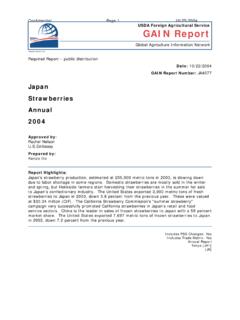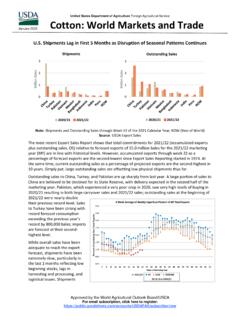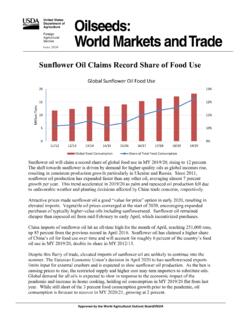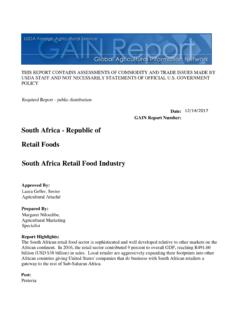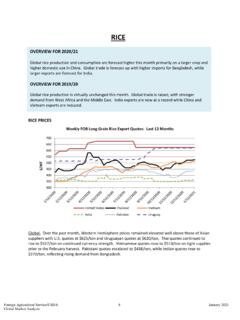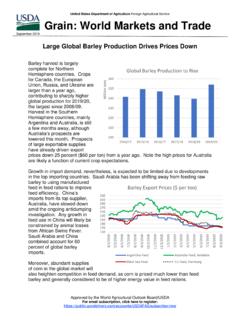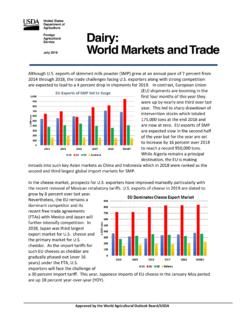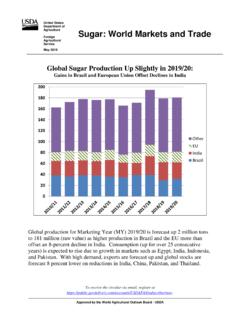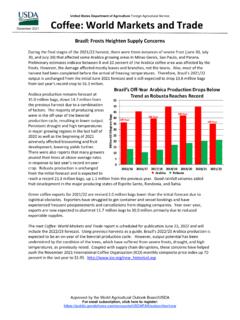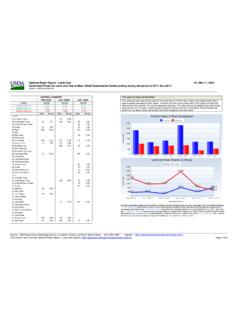Transcription of Philippines Retail Foods 2019 Food Retail Sectoral Report
1 THIS Report CONTAINS ASSESSMENTS OF COMMODITY AND TRADE ISSUES MADE BY USDA STAFF AND NOT NECESSARILY STATEMENTS OF OFFICIAL GOVERNMENT POLICY Required Report - public distribution Date: 7/8/2019 GAIN Report Number: 1913 Philippines Retail Foods 2019 Food Retail Sectoral Report Approved By: Ryan Bedford Prepared By: Joycelyn Claridades Rubio Report Highlights: The Philippine food Retail sector continues to grow, providing opportunities for increased exports of high-value food and beverages. The food Retail industry sold a record $ billion in 2018, and Post forecasts sales in 2019 at nearly $50 billion. Driven by rising incomes, a growing population, and a strong preference for American brands, the Philippines imported $ billion of consumer-oriented products in 2018. Post expects exports in this sector to grow further in 2019, reaching an all-time high of $ billion.
2 2 Market Fact Sheet: Philippines With a population of million and decreasing farmlands, the Philippines is dependent on food imports. In 2018, Philippine imports of high-value food products from the United States reached $ billion, making the United States the largest supplier for high-value, consumer-oriented food and beverage products. Post expects this to continue in 2019, with exports forecast to grow 10 percent to $ billion. The Philippines continues to be one of the fastest-growing economies in Asia. With a growing middle class and a large, young population, the Philippine economy is rooted in strong consumer demand, boosted by rising incomes and overseas remittances. Per capita gross income and consumer expenditures saw strong gains from 2012 to 2018. Imports of Consumer-Oriented Products: The Philippines is the largest market in Southeast Asia and the 10th largest export market in the world for high-value, consumer-oriented food and beverage (f&b) products, importing a total of $ billion in 2018.
3 Food Retail Sector: The Philippines traditional food Retail sari-sari stores ( mom & pop stores) still dominate the food Retail market, accounting for 58 percent. Despite aggressive expansion by modern food retailers, the Retail market is far from becoming saturated. Markets in the provinces remain both a challenge and a lucrative opportunity for modern food retailing companies. SWOT Analysis Strength Weakness The Philippines is a consumption-driven economy with a strong preference for food, beverage, and ingredient products. Philippine consumers can be highly price sensitive. Opportunity Threat A steadily growing middle-class means more disposable income spent on high-value products. exporters face competition from tariff-free products from countries including New Zealand, China, and Australia. 3 I. Market Summary Modern food Retail markets such as supermarkets, hypermarkets, convenience stores, and warehouse clubs have become essential, especially to those living in urban areas, as customers demand convenience and flexibility.
4 Modern markets are expanding in both urban and rural areas, and close to residential and commercial communities. Modern retailers are usually cleaner, more comfortable, spacious, and well maintained. Moreover, supermarkets offer a wider range of choices, including both perishable and non-perishable goods. The traditional wet markets retain an advantage in fresh product, including meat and seafood, and especially fresh fruits and vegetables. Trends in the Food Retail Market The rise of modern grocery retailers is starting to impact traditional grocery retailers (sari-sari stores and wet markets). Traditional and modern retailers can co-exist as they largely cater to different consumer needs. Among modern grocery channels, convenience stores serve as the biggest threat to traditional grocery retailers because they are targeting the same locations. Convenience stores have several advantages over traditional grocery retailers, such as a wider assortment of products, air conditioned outlets, and dining stations.
5 However, goods in convenience stores are more expensive than in traditional grocery outlets. Overall, modern grocery retailers still have a long way to go to saturate the market. The number of traditional grocery retailers in urban areas, especially Metro Manila, may slowly decline but this format will remain particularly strong in the provinces and rural areas. Over the last five years, warehouse clubs have been expanding throughout the country, with their total sales reaching a record $82 million in 2018. Represented by S&R Membership Shopping and Landers Superstore, these two major warehouse clubs both opened new outlets in 2018. Aside from a wide variety of food available, these stores also offer health and beauty products, home and outdoor items, household appliances, toys and fashion, and pet supplies. Although these stores are similar in format and size, Landers Superstore is deviating from the original warehouse club model as it also sells items in smaller packs, like those found in supermarkets.
6 This makes the store more accessible and affordable to 4 customers who require packaged food products and for families living in condominiums with limited storage. Both stores sell almost 90 percent and branded products. Types of Food Retailers in the Philippines Type Definition Supermarket A selling area of between 400 square meters and 2,500 square meters, at least 70% of which is devoted to food and everyday goods. Mostly located inside shopping malls, department stores, or within a commercial complex. Hyper Markets A hybrid of a department store and supermarket, with a sales area of at least 2,500 square meters, 35% of which is allocated to non-food products. Non-food items offered include furniture, appliances, and clothes. Convenience stores (including gas marts) A store with a sales area of 150-300 square meters that operates for longer hours (usually on a 24 hr. basis) and serves for impulse purchases.
7 Mostly found in condominium buildings, beside gasoline stations, near intersections or corner streets, or near a call center. Offers ready-to-eat meals and has a limited line of f&b and non-food/household items. Warehouse Clubs A large out-of-town store that sells goods in bulk at discounted prices to business and private customers who must first become club members. Sari-Sari Stores (Mom and Pop) Small neighborhood stores owned and managed by a household in the community, selling a variety of essential items such as rice, cooking oil, sugar, etc. Much smaller than convenience stores, they are usually built within or beside the operator/owner's own house. Wet Markets Usually sell "fresh" meat, fish, vegetables, fruits, and other domestically produced items. Mostly local products but offer some imported items, especially fresh fruits. Trends in Services Offered by Food Retailers Modern grocery retailers in 2018 continued to improve their smaller formats to keep up with changing consumer behavior demands of busy consumers.
8 Some supermarkets offer food-to-go counters and salad bars, while others integrate a pharmacy inside their store, making it a one-stop shop. Some convenience stores have incorporated fast-food services where customers can enjoy eating freshly prepared food in the store s dine-in area. Online grocery retailing is getting more popular in the Philippines . In 2018, this sector saw not only grocery retailers starting to launch their own e-commerce, but also third party marketplaces such as Lazada and Shopee introducing a dedicated platform for online grocery sales. Efficient service, speedy delivery, and a wide assortment of products will be necessary for the continued growth of online grocery retailing over the coming years. Consumer Taste and Preferences There are many factors driving the steady growth of the Philippine food Retail sector, including the robust overall economy, population growth, rising incomes, increasing numbers of dual-income families, fast-changing lifestyles, higher awareness of food quality and safety, and the growing sophistication of the market.
9 Growing demand for gourmet and healthy Foods , frozen foodstuff, ready-to-cook food, processed grocery items, and other food ingredients for home meal replacement are trending among Philippine consumers. As a country with a strong preference for brands, Post expects greater opportunities in the 5 Philippines for high-value, consumer-oriented products in the coming years. With the growing sophistication of the market brought by rising incomes, more products and brands will be marketable. Advantages (Sector Strengths) Challenges The Philippines is a mature and growing market for food, beverage and ingredient products with export sales of $ billion in 2018 and forecast to grow to $ billion in 2019. Stiff competition with other countries including New Zealand, China, and Australia. Filipinos have a strong preference for food, beverage, and ingredients products. products are not always price-competitive compared to other countries, especially from ASEAN.
10 Philippine consumers perceive brands to be safe and of high quality. Delivery/availability of products requires large inventories. Proliferation of malls encourages further expansion of food Retail establishments, leading to more demand of imported food items. Food retailers demand high slotting fees and year-round marketing support, placing a big burden on new-to-market exporters. Opening of modern Retail markets provides customers with more options for local and imported products. Local markets prefer smaller Retail packs due to affordability. Modern Retail markets are expanding, providing more Philippine consumers with access to new imported products. Availability of most imported products are concentrated only in Metro Manila and major key cities. Growing middle class means more disposable income spent on high-value products. Value-for-money remains the most significant influence of Filipino s purchase decisions.
